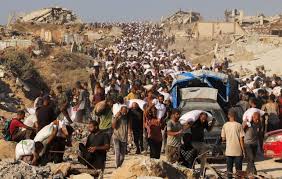Gaza Strip: Dire Warning: UN Says Aid into Gaza Too Sparse to Prevent Deaths — LIVE UPDATES
Gaza Strip – A senior United Nations office has issued a stark alarm: supplies trickling into Gaza are insufficient to halt mounting Palestinian deaths from hunger and disease. Despite tactical pauses designed to allow humanitarian aid, deliveries remain far below the needs dictated by a deepening famine. The UN warns that without rapid, large-scale assistance—especially fuel and medical supplies—death rates from starvation, dehydration, and preventable illness will continue to climb.

Key Facts
-
BREAKING: UN says aid flows to Gaza are mere trickles.
-
IMPACT: Millions at risk; children are dying from malnutrition.
-
OFFICIAL SOURCE: “People are dying and left without aid.” — OCHA senior official.
-
ACTION: Immediate expansion of aid corridors and scaled-up convoys required.
Hyperlocal Impact
-
Precise Location:
Gaza Strip (Over 2.1 million residents), especially northern Gaza City and Khan Yunis -
Community Connection:
“Children are dying before our eyes.”
— WHO spokesman describing conditions in local health centers.
Exclusive Angle
-
WHY THIS MATTERS NOW:
The crisis has escalated to famine conditions, with the UN’s Integrated Food Security Phase Classification (IPC) confirming Gaza is entering a “worst‑case scenario” of starvation, particularly affecting children and pregnant women. Fuel critical for hospitals, water, and bakeries remains severely restricted, threatening overall humanitarian system collapse.
Since the resumption of limited aid corridors, only a fraction of needed supplies has entered Gaza. Despite Israel announcing daily humanitarian pauses and allowing some convoys, these deliveries amount to just half the required volume to sustain life-saving services. Fuel remains at roughly one-third of daily needs, threatening electricity-dependency in hospitals, water pumps, sanitation systems, and aid delivery vehicles.
Malnutrition-related deaths have surged: WHO recorded 74 deaths this year, with 63 occurring in July alone, nearly one-third were children under five. Over 1,000 aid-seekers have died, many shot at distribution points or crushed in chaotic lines. Hospitals are overwhelmed; ambulances and generators frequently immobilized. Aid workers describe participatory hunger as “entirely preventable” if consistent access is established.
The famine has reached such severity that satellite imagery captured crowds swarming around aid trucks, reflecting desperation and scarce resources. IPC experts warn that unless aid volumes rapidly increase and corridors expand, tens of thousands more could die from starvation, dehydration, and illness related to collapsed health systems.
Update Log
-
July 27: Israel introduces limited humanitarian pauses.
-
~350 truckloads reported but still limited.
-
Today: UN warns current flow inadequate; deaths rising.


Comments are closed, but trackbacks and pingbacks are open.